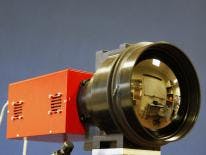Madrid, Spain--SENSIA Solutions, aspinoff of the Universidad Carlos III de Madrid (UC3M), has developed the first infrared (IR) camera (http://www.laserfocusworld.com/articles/2012/03/dual-laser-standoff-sensing-provides-strong-return-signal.html) for detecting sulfur dioxide (SO2), a gas that is considered one of the greatest causes of the acid rain generated by the energy, metallurgy, food, and paper manufacturing sectors. The device, based on technology patented by researchers from UC3M's Infrared Laboratory (Laboratorio del Infrarrojo - LIR), detects and measures, at distances of hundreds of meters, the SO2 and other pollutants (CO, NOx, SF6, hydrocarbons) that are usually invisible to the human eye. "The method and the device for detecting and measuring the concentration of gases that we've patented makes these compounds visible due to their characteristic infrared signature," says Miguel Ángel Rodríguez, an LIR scientist. "It's useful," he adds, "for identifying highly polluting vehicles that are on the road, leaks in conductions or emissions from industrial installations, such as the chimneys of power plants."
There are several instruments for detecting gases on the market but, according to the researchers, none of them offers the advantages presented by this new method: the ability to determine the individualized concentration of each gas that is present in the mix, and to do so from a distance and in real time. Thus, the infrared cameras developed by SENSIA Solutions make it possible for any user to detect these gases from hundreds of meters away, and in a very intuitive manner, according to the company's director, Francisco Cortés. "They can be installed and easily handled by workers in all kinds of factories or industries and can even be part of a permanent monitoring system that automatically activates an alarm when it detects the leak of a specific gas, such as SO2." The cost of these systems would not be greater than that of any classic IR camera, although it may vary based on certain parameters, such as the required detection distance or the concentration, among other factors.
SO2 is considered one of the most problematic contaminants and it is particularly harmful in India, Japan, and China (the greatest producers of this gas worldwide), a country where there are regions in which all the rain that falls is acid rain. This phenomenon occurs when the moisture in the air combines with SO2 and nitrogen oxides (which this new camera also detects) and forms sulfuric acid and nitric acids that fall to the earth with precipitation. This acidification affects the waters of lakes and rivers and hinders the development of aquatic life; it also affects vegetation, causing serious damage in forested zones. Moreover, acid rain can corrode infrastructures made of marble or limestone.
In urban centers, traffic and heating systems constitute the main sources of this type of pollution. Different studies have shown, however, that only a small proportion of the motor pool is responsible for most of the polluting emissions that are produced by automobiles. Therefore, to reduce the pollution caused by transportation, it is essential to detect and control the offending vehicles; this new generation of IR cameras could play an important role in this task. "The versatility of the method that we propose allows us to measure the exhaust from vehicles as they pass by on any type of road; and it can be done remotely and instantly," comments researcher Miguel Ángel Rodríguez. "Due to the device's extreme sensitivity, it is possible to detect even very low levels of emissions, and it can be adapted to the new legal limits that may be set for new models of automobiles in the future," he adds.
For SENSIA, having the patent incorporated as one of the company's technological assets will allow it to both innovate and compete in the market. The main activity of the firm is to adapt and optimize infrared technology to offer ad-hoc solutions to the problems that conventional thermography systems cannot address on their own. In order to do this, they offer advanced infrared thermography services, such as gas detection, production process control, and infrared analysis of materials and structures in service.
SOURCE: Universidad Carlos III de Madrid; http://www.uc3m.es/portal/page/portal/actualidad_cientifica/noticias/Researchers_develop_infrared_camera
